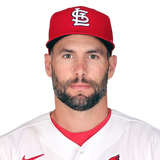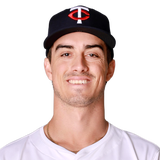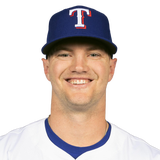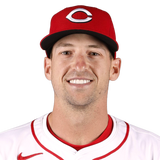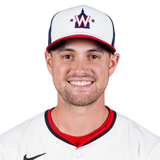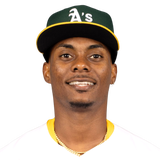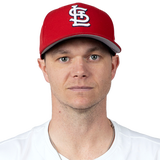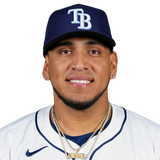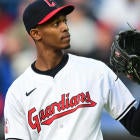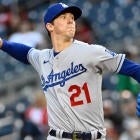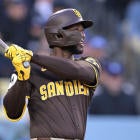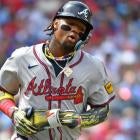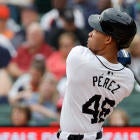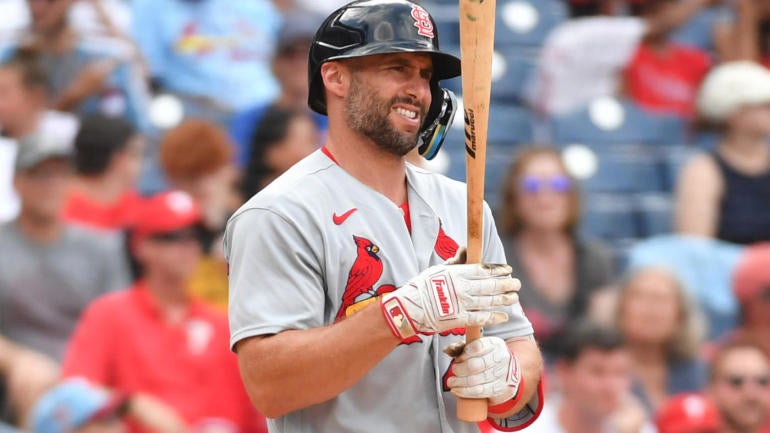
When I hear the word "bust," I picture ruin. Not just a depreciated asset, but toppled buildings and children left wailing in the streets.
I know many of you feel the same way, so I've tried to put together a list that shares in that understanding. Of course, no matter who I choose, there's a lower percentage chance of complete ruin than simple underachievement, but quibbling over the range of outcomes for a generally safe player only makes sense up to a point. If one fails to live up to his draft cost but is still a significant asset for you, is it such a big deal, really? Not at most levels of competition.
- Sleepers 1.0: Scott | Chris | Frank
- Breakouts 1.0: Scott | Chris | Frank
- Busts 1.0: Scott | Chris | Frank
So understand that the goal here isn't so much to maximize your drafting efficiency, which will be addressed in other ways between now and the start of the season, but to keep you from stepping on a land mine, your championship hopes replaced by strewn body parts.
In some cases, the cost may even be reasonable enough, but it still pays to go in knowing it could all blow up in your face.
Cody Bellinger, 1B/OF, free agent
| ||||||||||||
NFBC ADP: 53.4
I'm a little uneasy calling Bellinger a bust before finding out where he'll be playing in 2024, but even if he winds up back where he was in 2023, there are reasons to doubt whether he can repeat those numbers. The most obvious is what happened during the preceding three years, when he hit a combined .203 with a .648 OPS. True, he's also a former league MVP, claiming the honor in 2019, but his track record is equal parts success and failure at this point. The sheer inconsistency is reason enough to question what you're actually getting for your investment.
And it's not like he rebounded in every way last year. His exit velocities didn't return to 2019 levels, and in fact, his 87.9 mph average was his lowest on record, ranking in the bottom 25 percent of the league. His max exit velocity, for what it's worth, ranked in the bottom half. Those readings aren't the type we generally see for a middle-of-the-order bat, and Statcast estimates that the 26 home runs Bellinger hit last year would have been more like 19-23 at most other venues. He was one of the 10 biggest overachievers by xBA (.268 vs. his actual .307 mark) and one of the five biggest overachievers by xSLG (.434 vs. 525). And for as underwhelming as those expected stats were, just imagine them if he hadn't struck out a career-low 15.6 percent of the time.
There's certainly a glass-half-full outlook for Bellinger that presumes his miserable three-year stretch was the result of injuries wreaking havoc on his mechanics or that his diverse skill set will protect him from a true bottom-out scenario. But the poor exit velocity readings last year would seem to undermine the first point and his bottoming out from 2020 through 2022 would seem to undermine the second.
No team has been willing to meet his asking price yet, which itself should tell you someting.
Blake Snell, SP, free agent
| ||||||||||||
NFBC ADP: 64.0
I'm less concerned with where Snell will ultimately sign than I am Cody Bellinger, but as with Bellinger, the track record itself is the greatest cause for concern. Snell may be a two-time Cy Young winner, but he spent the four years in between struggling to justify himself. His numbers during that time -- a 3.85 ERA, 1.26 WHIP and 12.0 K/9 -- may not look so terrible, particularly the sparkling strikeout rate, but he didn't last even 130 innings in any of those four seasons. And it took a late surge in 2021 and 2022 to bring his numbers to a respectable level. As late as midseason, he had an ERA over 5.00 both years.
But it's worse than just him disappearing for stretches due to injury or having a blowup start from time to time. When he's off, he's close to unusable in Fantasy, squandering too many pitches on walks and strikeouts to make it more than five innings. There's a reason Snell's Cy Young seasons are his only two with double-digit wins despite him pitching for some pretty good Rays and Padres teams, and at times during those 2021 and 2022 seasons, there was even talk of dropping him in Fantasy. Can we feel confident he's nipped those efficiency issues in the bud? Well, he still averaged 5.0 BB/9 last year, so probably not. It's also the reason why he was the biggest overachiever in both FIP (3.44) and xERA (3.74) among full-time starters last year -- and there was no close second.
Snell did show improvement with both his curveball and changeup last year, giving him a deeper arsenal of swing-and-miss pitches than we had before, but remember, his first Cy Young came with a 1.89 ERA. We were all pretty bullish about his state of his development then, too. If the improved arsenal came with an improved walk rate, I'd be a little more forgiving of Snell's past, but even ignoring his past, the walk rate alone potentially makes for another Dylan Cease scenario.
Paul Goldschmidt, 1B, Cardinals
| ||||||||||||
NFBC ADP: 78.4
Part of me thinks Goldschmidt isn't worth mentioning here because the early ADP is more than reasonable for an early-round mainstay who's just a year removed from winning NL MVP and was batting .285 with an .850 OPS as late as July 26. In fact, I might even rank him higher than his ADP. Gee, I'm making a pretty good case for drafting him, aren't I? Well, here's where I'll remind you that my goal here is less about identifying draft inefficiencies and more about flagging potential land mines. And while there's still a good chance he'll be perfectly fine, I have an inkling Goldschmidt is about to blow up -- like, in a bad way.
For one thing, he's 36 now, and you may have heard that Father Time is undefeated. But he doesn't always reveal himself all at once. Sometimes you'll catch just a whiff of him, and I fear that's what happened with Goldschmidt in the second half. It's not just that he hit .246 with a .763 OPS. It's not just that his strikeout rate jumped from 21.8 to 25.6 percent. It's not even just that his average exit velocity dropped from 93.0 to 88.7 mph. Any of those on its own would be easy enough to dismiss as random variation in a fickle game, but all of them together, for a guy on the wrong side of 35, is something to worry about.
What's most worrisome of all, though, is Goldschmidt's splits against fastballs, which are purportedly the easiest pitch to hit because they take a relatively straight path to the plate. But as a player gets older, his swing slows down a bit, and he can have a harder time catching up to pure heat. It might explain why Goldschmidt, a career .307 hitter with a .995 OPS against fastballs, hit just .238 with a .797 OPS against them last year, swinging and missing 10.6 percent of the time compared to the usual 8.7 percent.
Ha-Seong Kim, 2B/3B/SS, Padres
| ||||||||||||
NFBC ADP: 80.6
At this time a year ago, Kim was known mostly as the defensive standout responsible for bumping Jake Cronenworth to first base and, in a less direct way, Fernando Tatis to the outfield. But he had turned himself into an instrumental Fantasy player by season's end, mostly by way of his new stolen base prowess. That has as much to do with the stolen base environment improving (through limited pickoff attempts, bigger bases, etc.) as anything, which means it may be here to stay. But even so, he's unlikely to improve upon the 38 steals he had last year.
And that's basically my entire objection to Kim for 2024. It just seems like he did everything as well as he could possibly do it in 2023. A clearer example of this is his power hitting. His 17 homers represent a nice, healthy total, particularly for a base-stealer, but he didn't impact the ball in a way that would suggest 17-homer power. His max exit velocity was only 39th percentile. His average exit velocity was only 7th percentile. And his hard-hit rate? Well, that was 3rd percentile. We're nearly at the bottom of the barrel. Granted, the shape of the contact also makes a difference. Kim elevated well to his pull side and may be able to repeat the feat. But that's working in opposition to his batting average, which Statcast suggests should have been .245 rather than his actual .260 mark.
It wouldn't take much for Kim to slip to just 12 homers and 30 steals -- in which case he's Tommy Edman, who's going half a draft later. And I suspect there's even more downside risk from there.
Joe Ryan, SP, Twins
| ||||||||||||
NFBC ADP: 94.8
My approach to starting pitching this year (at least in 5x5 categories leagues) is to sell out for strikeouts, believing that blowup starts have become too common to put much stock in ERA and WHIP. But as with any sweeping changes to my approach, it's more of a guideline than a rule, and for someone like Ryan, I think the ERA risk is too great to pursue the 11.0 K/9. I say this not just because he had a 4.51 ERA last year, but because I think all of it, the strikeouts included, could get even worse.
In short, the jig is up. Ryan was never a hard thrower. He never featured much of a secondary arsenal. What made him so effective -- both in the majors and especially the minors -- was the shape of his fastball. Its low release height gave it the optimal vertical approach angle to dominate at the top of the zone, which was very much on trend with current best pitching practices. It's so on trend, in fact, that hitters have begun to adjust. "The worm is turning in the battle for the top of the zone," Eno Sarris wrote for The Athletic in October. What was once considered good ride for a fastball, he points out, yielded a .355 wOBA in 2023, up from .304 just a year earlier.
Ryan's entire career is built on that gimmick, so if the effect has worn off, the fall could be tremendous. And it may have already started. While his ERA finished at 4.51, it was 2.98 as late as June 26. Such a jump amounts to a 6.62 ERA over his final 14 starts, along an untenable home run rate of 3.2 per nine innings. Now, he was pitching through a groin injury for part of that time, which might explain the worst of his struggles, but seeing as he had a 4.79 ERA in seven starts after returning, I can't rule out the possibility that he's just done.
Josh Jung, 3B, Rangers
| ||||||||||||
NFBC ADP: 101.3
There seems to be a fundamental disagreement over how good Jung actually is -- one that I trace back to the first two months of last season, when he hit .295 with 12 homers and an .872 OPS. At the time, I said it was a mirage, that his middling exit velocities wouldn't hold up to his inflated strikeout rate. And you know what? He hit just .244 with 11 homers and a .712 OPS the rest of the way, a span of 70 games compared to 52.
So why the disconnect? I think it's just because those 52 games happened during the time of year when Fantasy Baseballers were playing closest attention, and their impressions of Jung became entrenched. But again, the warning signs were there before the drop-off even began. To put actual numbers to it, Jung struck out 29.3 percent of the time last year. Only seven qualifying batters struck out more, and their combined batting average was .235. It's true that we've seen players strike out that much and still deliver a quality batting average, but it usually requires the sort of outlier exit velocities that Jung doesn't seem capable of delivering. Yes, he did hit the ball hard on average in 2023, but it's the high-end readings that matter more for power production. Jung's max exit velocity was only 58th percentile.
Given that profile, I'd say that Jung's final 70 games are closer to his true self than his first 52 games. I'm willing to split the difference and value him based to his overall numbers, but that puts him closer to Alec Bohm than Nolan Arenado, in my estimation, even though early ADP says otherwise.
Spencer Steer, 1B/3B/OF, Reds
| ||||||||||||
NFBC ADP: 105.5
Steer was one of the biggest finds in all of Fantasy last year, ranking fifth among third basemen in points leagues and eighth in Rotisserie, with eligibility at first base and the outfield as well. He made worthwhile contributions in batting average, home runs and stolen bases and did it all as a rookie. But my concern is that we happened to get his best-case outcome on the first try, and I think the odds are against him doing it again.
Just on a pure skill level, my skepticism is warranted. You'll notice I described his contributions in batting average, home runs and stolen bases as "worthwhile?" Yeah, he wasn't a standout in any of those areas, which makes for a slimmer margin for error in all three. And because his whole is basically the sum of his parts, any slippage in one could upend the whole thing. So let's examine those possibilities for slippage. Of his 15 stolen bases, more than half came in June. He didn't show much willingness to run otherwise. His average exit velocity was only 37th percentile, his max 63rd percentile. Fair to say, then, he's not exactly scalding the ball, and so you may not be surprised to learn he outperformed his .252 xBA by 19 percentage points and his .417 xSLG by 47.
It's true he plays in the majors' most homer-friendly park, which helps to make up for those shortcomings, but in order for that to happen, he does have to play. And this is the kicker for me. For whatever talents Steer brings to the table offensively, they don't compare to Elly De La Cruz, Noelvi Marte, Matt McLain and Christian Encarnacion-Strand, to say nothing for holdover Jonathan India and free agent addition Jeimer Candelario. Between those six, the infield is no longer an option for Steer. Now, if he's as good as last year, he'll suit the Reds just fine in the outfield, but with TJ Friedl, Will Benson and Jake Fraley all vying for at-bats as well, and all batting left-handed, could any slippage lead to a playing-time crunch? It seems more than plausible.
Lane Thomas, OF, Nationals
| ||||||||||||
NFBC ADP: 107.7
Thomas seems like too easy of a choice here, being a fourth outfielder type who overachieved for half a season before coming back down to earth with a .223 batting average and .705 OPS in the second half. That pretty much sums it up, right? But here he is still being drafted ahead of such notables as George Springer and Evan Carter.
There are some complicating factors here, such as Thomas still hitting 14 homers and stealing 12 bases during that 68-game stretch when he was batting .223 -- strong totals, to be sure. And nobody should think .223 is the true baseline for him anyway. He entered the year a career .237 hitter. Meanwhile, his role is probably safe on a still-depleted Nationals club. And then there's the biggest complicating factor of all, the fact that outfield is terrible after the top 25 or so are off the board. That's about the point when Thomas is being drafted. If your biggest need is outfield at that point, investing in the guy coming off a 28-homer, 20-steal season is no crazier than investing in anyone else.
But maybe it's just crazy to invest in any outfielder at that point, and you shouldn't put yourself in a position where you're tempted to do so. If the goal here is to identify potential land mines, Thomas certainly qualifies as one -- and at a point in the draft when there are still quality alternatives, if mostly at other positions.
Esteury Ruiz, OF, Athletics
| ||||||||||||
NFBC ADP: 122.4
I'd venture to say that everyone reading this knows Ronald Acuna led the majors with 73 stolen bases last year. But second was Ruiz with 67, and the gap between him and No. 3 (Corbin Carroll with 54) was bigger than at any other place on the leaderboard. Of course, Acuna (and Carroll, for that matter) contributed in a multitude of other ways while Ruiz pretty much just stole the bases. He's about as one-dimensional as players get, and that one dimension isn't as useful as it once was.
I think the reason Ruiz is being drafted about 70 spots higher than I rank him in Rotisserie leagues is that our collective sensibilities haven't caught up to our new reality yet. The 3,503 stolen bases across the majors last year were 41 percent more than the year before and the most since 1987, which means virtually no one playing Fantasy Baseball today can recall a time when they were so plentiful. And it's a particularly stark contrast to the juiced ball years, when there was no higher priority than stolen bases on draft day. You could have presumed in those days that a 67-steal guy would carry you in a category where few player were of any use at all. It was scarcity that made a player like Ruiz valuable, but that scarcity doesn't exist anymore.
Which brings me back to what he doesn't do -- i.e., everything else. His quality-of-contact readings are some of the worst in all of baseball, and the way he angles the ball doesn't offer much hope for sneaky power either. He's an overly aggressive hitter, too, which means he's not even getting on base enough to take full advantage of his speed. And perhaps the biggest case for him being a bust is that by season's end, he had become too much of an offensive liability even for the lowly Athletics, starting only half of their games from Aug. 5 on.
Sonny Gray, SP, Cardinals
| ||||||||||||
NFBC ADP: 124.3
While it's true Gray secured some Cy Young votes, enough to finish second, in a down year for pitching in general, he was in many ways the same as he's always been. His strikeout and walk rates were virtually identical to the year before. His xERA and xFIP were both about 80 points higher than his 2.79 ERA, putting him in the same mid-to-high threes range where he's resided since 2019.
His FIP stands out by comparison, actually topping the leaderboard at 2.83, but that's because FIP is calculated using actual home runs rather than the likelihood of home runs. Good home run luck was a key to Gray's success in 2023. He surrendered only eight all year, a feat he's unlikely to repeat. Some will point to his sweeper as a game-changing pitch, accounting for a 41.3 percent whiff rate, but his overall swinging-strike rate (11.4 percent) was merely decent and not out of character for him. He also rarely threw the pitch for strikes, and over time, hitters will learn not to chase it.
All of that doesn't even take into account the biggest concern of all. More than his ERA, his FIP or his sweeper, what moved Gray into the Cy Young conversation last year was his 184 innings pitched. He hadn't reached 180 in a season since 2015, averaging 140 in the six seasons thereafter (2020 excluded, for obvious reasons). Standing only 5-feet-10, his body generally hasn't held up to being a full-time starting pitcher, and a single departure from the trend isn't enough to upend the trend. Is the likelihood of 140 innings from a middling strikeout pitcher with a spotty ERA history really something to stake your season on? As anything more than a back-end rotation stabilizer -- which is mostly how he's been regarded over the years -- it wouldn't be for me.
Isaac Paredes, 1B/3B, Rays
| ||||||||||||
NFBC ADP: 178.8
One telltale sign of a bust candidate is a player who relies on a single trick to make him everything he is. Joe Ryan is one such example, but Paredes is another. The basis of his appeal is his power production -- he hit 31 homers and drove in 98 runs last year -- but his profile isn't that of a slugger at all. A quick look at his Statcast page will reveal nothing but icy blue, his max exit velocity ranking in the 33rd percentile, his average exit velocity in the 13th percentile and his hard-hit rate in the 6th percentile. His .488 slugging percentage was 119 points higher than his .369 xSLG, which was the second-biggest gap among all hitters.
For him, it's all about the angles. Rather than hitting majestic home runs from gap to gap, he takes aim for the shortest part of the fence and is able to sneak it over enough to count for something. His fly-ball rate last year was 47.0 percent, which ranked 11th among qualifiers, and his pull rate on fly balls was 45.4 percent, which ranked second only to Adam Duvall. The resulting spray chart looked like this:
Who is this? pic.twitter.com/2OnmNgvlvl
— Scott White (@CBSScottWhite) January 19, 2024
In theory, it should continue to work, and in fact, it's been a two-year trend now. But consider how much of an outlier it requires Paredes to be, particularly with regard to hitting fly balls to his pull side. His 45.4 percent rate was nearly twice the league average of 24.9 percent. Any regression there could spell disaster given that weakly hit fly balls to any other part of the yard are easy outs. And even if he's able to maintain the outlier rate, maybe some of those 31 homers fall short of the fence this time, resulting, again, in easy outs. As fickle as the Rays are with their lineups, how many chances do you think they'll give Paredes if he's hitting .220 in mid-May?
Bryce Miller, SP, Mariners
| ||||||||||||
NFBC ADP: 187.8
The enthusiasm for Miller is built on the same flimsy foundation as the enthusiasm for Josh Jung. Basically, everyone remembers how it started and less so how it finished. So let me break it down for you. Through five starts, the right-hander had a 1.15 ERA, going six-plus innings in all five. In 20 starts thereafter, he had a 5.31 ERA, going six-plus innings in just four.
I don't know which sample is more revealing to you, but when the more recent one also happens to be four times larger, it shouldn't be a difficult decision.
The big issue for Miller is that he's essentially a one-pitch pitcher, throwing his fastball 60 percent of the time. It's a good fastball, featuring just 11.8 inches of drop, but when there's little to counteract it, hitters eventually figure it out. He did begin mixing in other pitches as the season went on -- mostly different variations of a fastball and slider -- but none of them proved to be particularly effective. The overall results also didn't improve at all as he threw them more. He has been working on a splitter this offseason, but its impact is theoretical at this point.
Of course, Miller did throw 67 percent of his pitches for strikes, which is particularly impressive for a rookie and somewhat reminiscent of George Kirby, another young Mariners pitcher who has struggled to develop much of a secondary arsenal. I underestimated Kirby at one point, and it's possible I'm doing the same for Miller. But the results were always there for Kirby while for Miller, apart from those first five starts, they just weren't. The upside is much clearer to me for pitchers like Nick Pivetta, Shane Baz, Ryan Pepiot and Nick Lodolo, all of whom are being drafted after Miller, on average.












